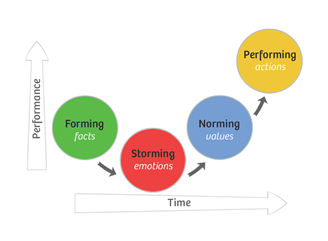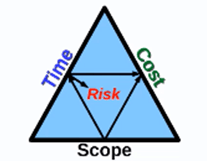- Home
- Business Innovation
- How to create an effective and successful Project Management Plan
Business Innovation
10
min read
How to create an effective and successful Project Management Plan


Don't you want to read? Try listening to the article in audio mode 🎧
This article explains how to create a digital project management plan, starting from the traditional principles of the PMP.
It is not just a guide on project management, but a path along all the project phases, identifying the different roles and stakeholders involved in the project, and the dynamics and rules to be respected to bring it to completion.
If we are thinking about creating a project management plan, we must begin from the definition of “project”, first of all.
We can define a project as:
“any undertaking, carried out individually or collaboratively and possibly involving research or design, that is carefully planned (usually by a project team but sometimes by a project manager or by a project planner) to achieve a particular aim. It seeks the realization of a unique and innovative deliverable, such as a product, a service, a process, or in some cases, a scientific research.”
Source: Wikipedia
The formal definition is useful because it helps us understand the project management process, which highlights actions over time to a predefined purpose achievement:


- Time, these are not ongoing activities but operations for which it is essential to create a work team, quantify a necessary effort, deliver a product, a service or a result.
- Purpose, it represents the project’s heart and it requires the grounding of best practices (that we will see in the following paragraphs), and outputs that can allow the monitoring and control of the effort and the defined timeframes for the achievement of a successful project.
- PM, project manager
- Core project team, small group operating on the project
- Project team, all team members involved in the project
- Stakeholders, all the people you need to inform, involve and for whom to be of support
- Customer, project end user
- Sponsor (if any), for the financing of the project, which is frequently combinable with the figure of the customer
The role of PM and project team
The Project Manager must be one, with authority and responsibility to plan, manage the project and ensure that all best practices are always implemented. PMs represent the contact point for the project team, the stakeholders and the customer. They have to be able to bring to attention the project dynamics, the work progress, and especially explain when something is going wrong in the project. They have the courage and the authority to ask for anything in order to achieve the goal, and bring the project to completion. The requirements for pursuing the activity of project manager are varied and diverse. Let’s see below:- Organizational skills, a project manager must have basic organizational skills, among the most important are being able to keep track of activities through a to-do list, to prioritize and reprioritize the planned activities and take them over in order of importance for the project.
- Project management and sector skills, this means having previous experience in project management, having followed training and updates on the general and specific subject, and within the scope and fields specified in the project. The knowledge of the digital areas foreseen in the project allows the project manager to easily carry out the management of the internal team and external stakeholders, including relationships and communications with end users (the customer).
- Soft skills, finally, having acquired soft skills facilitates communication, negotiation, team management and the sense of leadership required in project management.
- Listen actively
- Ask for confirmation of correct communication → did I understand correctly? Just to understand if we are on the same page.
- Quickly understand the problems of communication → is the chat really the right place? How many people work on the project? You are not interchangeable.
- Forming
- Storming
- Norming
- Performing

(Source: PMBOK®)
Truckman identifies these 4 development phases of the project team, which are sequential between them. The team consists of people with heterogeneous characteristics and peculiarities in terms of relationships, personalities, experience gained in the field, technical and specialist skills and so on. The role of the PM is to transform a group of people into a real team in a short period of time, promoting interaction, cross-team competence and increasing group performance. It starts with the forming stage, in which the team members meet each other for the first time and, with the help of the PM, the sharing of information on their backgrounds, interests and experiences happens. In this phase, the first information about the project, objectives, roles and responsibilities are acquired. After forming, we move on to the storming stage, in which members start working on project activities and obviously it is easy to run into disagreements, especially if it is a newly formed team. In this stage, PMs must make their presence felt and guide the team to solve the problems that have emerged, encouraging a collaborative atmosphere. After the storming stage, then we reach the norming stage, where all members begin to work in synergy and more efficiently to achieve the project’s goals. Here, The PM monitors and intervenes in a more discreet manner within the team, by empowering the group, and always making sure that it is working in a collaborative and efficient atmosphere. Finally, we come to the performing stage where the team's goal is to achieve the project’s final result. PMs, at this stage, may not even get into the teamwork’s daily routine, or in the heart of decision-making and problem-solving processes. However, as mentioned above, project managers are team leaders and in charge of the project and they must constantly monitor the performances.The life cycle of a project
The life cycle of a project consists of five main phases for which the project manager and the work team try to achieve the targets that the project sets out. For each phase or activity of the life cycle, the project manager must have a clear idea regarding the purposes of each phase of the project: on the basis of company constraints ranging from quality to timing and costs. During the initiating phase, among the various activities of fundamental importance we find the identification of the project’s goal, in which we determine what will be the outcome and the benefits it will bring to the customer. After having carried out a preliminary analysis of project feasibility, there is the project team creation which takes shape in relation to the skills and areas planned in the project. From here, you can move on to the preparation or planning phase. It starts from the goal identified in the start-up phase that is described in detail, by planning the steps needed to achieve it. Then, a project plan is created, and the individual tasks and requirements, that are needed for completion, and the timing are identified. Project managers also coordinate the drafting of the project budget and, based on this, they estimate the project efficiency. After that, the planning process is complete. The preparation phase is also handy for the project team in order to identify all stakeholders and establish a communication plan that presents all necessary information to keep all parts involved in the project informed. The actual implementation of the project, following what is defined during planning, takes place during the execution phase. During this phase, the owners of the project tasks carry out their duties, and the status of the activities is constantly monitored, in order to permit any necessary correction and organizing regular internal updating meetings and external SALs with the stakeholders involved. The project manager, through this shared information, is responsible for controlling the direction of the project allowing corrective actions to be taken if necessary. Any changes to the project plan must be promptly agreed and formalized with the project stakeholders. Special attention goes to the constant monitoring of project efficiency, through which the performance of the work team involved is assessed with regards to the project’s budget. The notion of triple constraint, in this planning phase, becomes increasingly severe. There is a fundamental relationship between goal, time and cost. The role of the project manager within the team is precisely to always maintain a balance between them. Starting from the Scope (goal), in order to enable an accurate understanding of Time and Cost. By changing one of the three, the other two will change accordingly, with the possibility of increasing project risks. If these three points are in equilibrium, we will not have particular project risks.
(Source: Udemy)
The closing phase sees the communication of the completion of the project to all those involved, the delivery of the project outputs and the presentation of the final results. It must be remembered that it is not only important to close a project successfully, but also to be able to do it within the time schedule and in the conditions predetermined in the original plan.Creating a project management plan
We are at the end of this article, in which we are going to see how to draw up a project management plan. This describes the essential elements of the project providing a clear picture of its structure and consists of the background, scope, schedule, budget, any risks and any additional information required. The plan must be reviewed and approved before the execution of the project. Starting from the background, the project management plan will include:- needs, which include the problems or opportunities for which the project was designed;
- customer information, or rather the organization that supports the payment of the project with a person identified as a formal contact point. If there is a sponsor, the customer would be considered the end user who must also be indicated in the plan with a specific referent;
- business cases, that is an analysis that shows the advantages of the project compared to the expected costs.
- the project’s goal, the most important concept seen when reading this article, which describes the final result and the benefits agreed with the stakeholders during the initiating phase;
- requirements, that is all that is necessary to achieve the goal;
- the solution, a description of the proposed solution with a graph where possible;
- the work breakdown structure, or WBS, in which are represented all the deliverables that will be provided to the client at the end of the project plus all those that will be produced by the project team and provided to each other only to accomplish the project.
The kick-off meeting
Once the project management plan has been finalized, we therefore ask ourselves how to start the project execution phase. Kick-off meetings are those events to be considered mandatory, in the first place. Usually, if set well, they allow the project to be streamlined upstream, saving days or weeks that could slow it down during construction. Therefore, they should always be organized even when we think that all the actors involved already know everything. There are two types of kick-off meetings:- internal kick-off meeting, planned on the first day of project execution, in which is involved the entire project team, project manager, delivery director, business process director, supervisory figures of specialist teams, specialists, any suppliers. The essential elements of the project plan are illustrated with a focus on needs and so, a presentation of the project perimeter with the objectives to be achieved, the WBSs to be set, a Gantt chart with the milestones defined for each macro activity and the micro activities, without neglecting any risks and problems that may be encountered during the planning phases.
- external kick-off meeting, the next step after the internal one is to bring together all the relevant stakeholders including the customer, the team, the key partners. Then, it is to present the plan, the planned activities, the project requirements and resolve any doubts that emerged during the internal meeting. In fact, many of the requirements can be provided or corrected by the customer himself. It is crucial to review each requirement discussed, as necessary, and add any requested clarifications, then arrange those clarifications and requirements in all subsidiary documentation.
The closure of the project
As well as the project management plan’s initiating phase it is fundamental to the success of the project, the purpose of the closure is to conclude the project in an organized way and make sure that nothing is forgotten. Or rather, ensuring that all the activities are complete, that everything has been delivered and that the contracts are formally closed. Furthermore, that clients verify that the result of the project will be useful for the purpose and they will accept it. The project output must be suitable for the purpose. A final meeting will therefore be organized to present the output, involving the internal team of the project and external stakeholders, including the customer. The project manager is responsible for leading the closing phase and making sure it goes well, as everything that has been done previously in the project depends on the successful management of this phase. Source: udemy (Deeply Practical Project Management)Some useful Project tools
The set of processes required to manage a project includes numerous steps and actors to involve, documents to share, deadlines to plan, efforts to monitor. In order to help he project manager in carrying out his work, the project management tools allow to rationalize and run a project and, above all, to automate some activities minimizing the risk of errors. There are several free-to-use open-source software and paid web platforms that integrate functionality with collaboration environments that can be used by the project team. These elements are various:-
- Jira
Article updated on: 09 August 2023

Don't Waste Your Talent. Turn It Into a Career With a Course That Fits Your Needs!
Talent Garden is your Digital Skills Academy, offering courses in Digital Marketing, UX Design, Digital HR and Data Analysis designed to launch your career.
Keep reading

7
min read
What is Project Management: How much does it earn and what does a Project Manager do?
Only a few job roles are as truly versatile as a Project Manager. Not only is Project Management needed in an array of ...
Talent Garden
22/07/2020

9
min read
8 Best Project Management Software & Tools in 2020 for Effective Project Managers
Like every superhero, project managers need their own gadgets and tools. Thankfully, we have more at hand nowadays than ...
Talent Garden
08/09/2020

12
min read
UX Design: A complete guide to plan an efficient User Experience
When creating any digital project, the focus must now be on the user. Websites, marketing campaigns, posts and social ...
Talent Garden
22/01/2019

4
min read
Choosing the right Project Management Methodology interview with Maja Lidberg
Project Management methodologies like Agile, Scrum and Kanban have become an everyday part of our business vocabulary. ...
Talent Garden
18/09/2020
